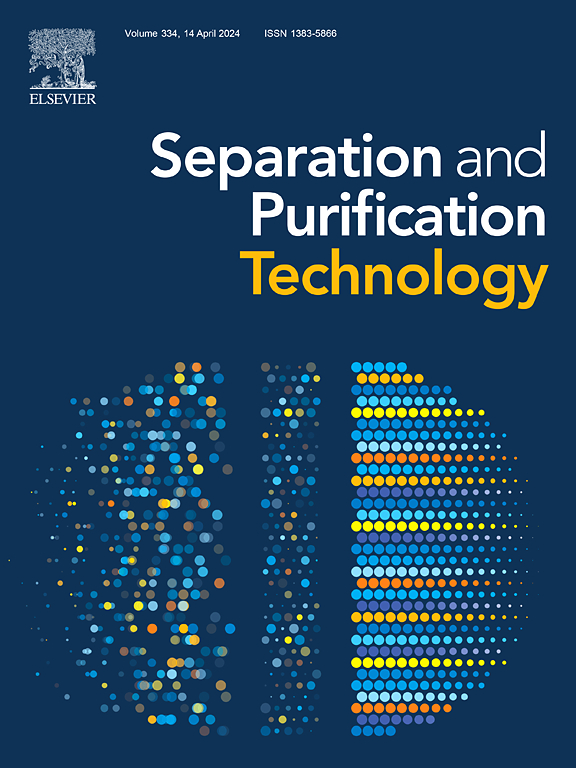解锁微孔碳在复杂空气混合物中对甲醛的全部吸附潜力
IF 9
1区 工程技术
Q1 ENGINEERING, CHEMICAL
引用次数: 0
摘要
微孔活性炭(AC)在空气净化系统中的广泛应用受到其对低沸点极性化合物(如甲醛(FA))的有效性的质疑,特别是当存在于复杂的多组分流中时。为了提高吸附剂的实用化程度,本研究系统地研究了商用交流床吸附剂对FA的吸附行为。该分析结合了竞争组分的存在(例如,芳烃[BTX],氧化[乙醇]和水蒸气),并精确控制关键变量:填料AC粒径(小[AC- s: 0.075-0.212 mm],中[AC- m: 0.212-0.6 mm]和大[AC- l: 0.6-1.7 mm]),相对湿度[0.015 %至100 %],进口FA浓度[50-500 ppm]),和气相组成(单组分和多组分流)。微量湿度条件下(5 ppm H2O)对100 ppm FA的99 % BT吸附量(mg g−1)受AC- m(12.0) >; AC- s(9.8) >; AC- l(5.8))的适度影响。BTX严重降低FA的摄取(77.5-96.0 %)并诱导卷起效应。然而,湿度和乙醇通过增加极性表面基团来协同促进FA的吸附,减轻BTX的竞争。FA吸附遵循Freundlich等温线,表明物理吸附。动力学从较小的AC颗粒的伪一阶转变为较大的AC颗粒的伪二阶,反映了扩散差异。光谱研究表明,水和乙醇起着双重作用:它们通过氢键和中等水平的多聚甲醛形成帮助吸附,同时在饱和时阻断位点。这项研究为调整交流特性提供了重要的见解,为设计适用于复杂环境的应用吸附剂铺平了新的道路。本文章由计算机程序翻译,如有差异,请以英文原文为准。


Unlocking the full adsorption potential of microporous carbon for formaldehyde in complex air mixtures
The widespread application of microporous activated carbon (AC) in air purification systems is challenged by its questionable efficacy against low-boiling, polar compounds, such as formaldehyde (FA), particularly when present in complex, multi-component streams (e.g., aromatic hydrocarbons [BTX], oxygenated [ethanol], and water vapors). Aiming to enhance its practical utility, this study undertakes a systematic investigation into the FA adsorption behavior of a commercial AC bed adsorbent with precise control over the packing particle sizes (i.e., small [AC-S: 0.075–0.212 mm], medium [AC-M: 0.212–0.6 mm], and large [AC-L: 0.6–1.7 mm]). Emphasis is also placed on the effects of relative humidity [0.015 % to 100 %], inlet FA concentrations [50–500 ppm]), and gas phase composition (non-competing single and competing multi-component streams) on the breakthrough (BT) adsorption dynamics of FA onto AC bed adsorbents. The 99 % BT adsorption capacity (mg g−1) for 100 ppm FA under trace humidity conditions (5 ppm H2O) is moderately influenced by AC particle size (AC-M (12.0) > AC-S (9.8) > AC-L (5.8)). BTX severely reduces FA uptake (by 77.5–96.0 %) and induces a roll-up effect. However, humidity and ethanol synergistically enhance FA adsorption by increasing the number of polar surface groups, which in turn suppresses the competition from BTX. The dominance of physisorption for FA is suggested by its adherence to the Freundlich isotherm. Kinetics transitions (e.g., from pseudo-first-order for smaller AC particles to pseudo-second-order for larger ones) is indicative of their differing diffusion mechanisms. Spectroscopic studies reveal that water and ethanol play a dual role: they aid adsorption via hydrogen bonding and paraformaldehyde formation at moderate levels, while blocking sites at saturation. This research offers crucial insights into tuning AC properties, paving the new way for the design of application-ready adsorbents for complex environments.
求助全文
通过发布文献求助,成功后即可免费获取论文全文。
去求助
来源期刊

Separation and Purification Technology
工程技术-工程:化工
CiteScore
14.00
自引率
12.80%
发文量
2347
审稿时长
43 days
期刊介绍:
Separation and Purification Technology is a premier journal committed to sharing innovative methods for separation and purification in chemical and environmental engineering, encompassing both homogeneous solutions and heterogeneous mixtures. Our scope includes the separation and/or purification of liquids, vapors, and gases, as well as carbon capture and separation techniques. However, it's important to note that methods solely intended for analytical purposes are not within the scope of the journal. Additionally, disciplines such as soil science, polymer science, and metallurgy fall outside the purview of Separation and Purification Technology. Join us in advancing the field of separation and purification methods for sustainable solutions in chemical and environmental engineering.
 求助内容:
求助内容: 应助结果提醒方式:
应助结果提醒方式:


